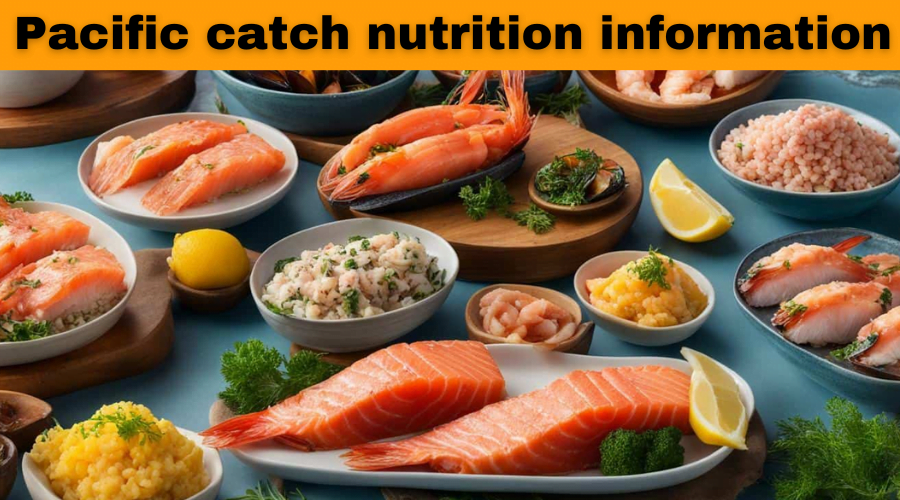Introduction
Pacific catch nutrition information for the various types of fish that are caught in the Pacific Ocean. These fish are not only a delicious source of fuel with flavor, but they also offer numerous nutritional benefits. Pacific Catch is known for its high protein content, low saturated fat, and rich vitamins and minerals. Additionally, it is a great source of omega-3 fatty acids, which have been linked to various health benefits. In this article, we will explore the nutritional benefits of Pacific catch, the different types of fish available, and how to incorporate them into a healthy diet plan.
Nutritional Benefits of Pacific Catch
One of the main reasons why Pacific Catch is highly regarded as a nutritious food source is its high protein content. Protein is essential for building and repairing tissues, as well as for the production of enzymes and hormones. Pacific catch is also low in saturated fat, making it a healthier alternative to red meat. Additionally, it is rich in vitamins and minerals such as vitamin D, vitamin B12, selenium, and potassium.
Types of Pacific Catch and Their Nutritional Profiles
There are several types of Pacific catch nutrition information that are commonly consumed. These include salmon, tuna, halibut, cod, sardines, and mackerel. Each type of fish has its own unique nutritional profile. For example, salmon is known for its high omega-3 fatty acid content, while tuna is a great source of protein. Halibut is rich in vitamin B12 and selenium, while cod is high in potassium. Sardines and mackerel are both packed with omega-3 fatty acids and other essential nutrients.
Comparison of Pacific Catch to Other Sources of Protein
When it comes to protein sources, Pacific Catch offers several advantages over other options. Compared to red meat, which is often high in saturated fat, Pacific Catch is lower in saturated fat and provides a healthier source of protein. It is also a great alternative to chicken. As it offers a wider range of nutrients and is often more flavorful. Additionally, for those following a plant-based diet. Pacific catch can be a valuable source of protein and essential nutrients that are often lacking in plant-based protein sources.
Omega-3 Fatty Acids in Pacific Catch and Their Health Benefits
One of the key nutritional benefits of Pacific Catch is its high omega-3 fatty acid content. Omega-3 fatty acids are a type of polyunsaturated fat that are essential for our health. They play a crucial role in heart health by reducing inflammation, improving blood flow, and lowering blood pressure. Omega-3s are also important for brain health, as they are a major component of brain cell membranes and can help improve cognitive function. Additionally, they have been shown to reduce inflammation in the body, which can help alleviate symptoms of chronic diseases such as arthritis.
Vitamin and Mineral Content in Pacific Catch
In addition to being a great source of protein and omega-3 fatty acids, Pacific Catch nutrition and information is also rich in vitamins and minerals. One notable nutrient found in Pacific Catch is vitamin D, which is essential for bone health and immune function. Vitamin B12 is another important nutrient found in Pacific Catch, which is necessary for producing red blood cells and properly functioning the nervous system. Selenium is a mineral that is abundant in Pacific Catch and acts as an antioxidant, protecting cells from damage. Lastly, potassium is an essential mineral that helps regulate blood pressure and maintain proper heart and muscle function.
Sustainable Fishing Practices for Pacific Catch
It is important to note that sustainable fishing practices are crucial for the long-term health of our oceans and the fish populations within them. Overfishing can lead to the depletion of certain species and disrupt the delicate balance of marine ecosystems. To ensure that Pacific catch is sourced sustainably. There are certification programs in place that assess and verify the sustainability of fishing practices. These programs. Such as the Marine Stewardship Council (MSC) and the Aquaculture Stewardship Council (ASC). Provide consumers with the assurance that the fish they are purchasing has been caught or farmed in an environmentally responsible manner.
How to Prepare and Cook Pacific Catch for Maximum Nutrition
To maximize the nutritional benefits of Pacific catch nutrition information, it is important to choose cooking methods that preserve the natural flavors and nutrients of the fish. Grilling is a popular method that adds a smoky flavor to the fish while retaining its moisture. Baking is another healthy option that requires minimal added fats and preserves the natural flavors of the fish. Poaching is a gentle cooking method that involves simmering the fish in liquid, such as water or broth, which helps retain its moisture and delicate texture. Lastly, steaming is a quick and easy method that preserves the natural flavors and nutrients of the fish without adding any additional fats.
Incorporating Pacific Catch into a Healthy Diet Plan

Incorporating Pacific Catch into a healthy diet plan is relatively easy and can be done in various ways. The American Heart Association recommends consuming at least two servings of fish per week, with each serving being around 3.5 ounces. This can be achieved by including Pacific Catch in salads, stir-fries, tacos, or grilled fish with vegetables. It is important to vary the types of fish consumed to ensure a diverse range of nutrients.
Pacific Catch as a Source of Fuel for Athletes and Active Individuals
For athletes and active individuals, Pacific Catch can be an excellent source of fuel due to its high protein content and omega-3 fatty acids. Protein is essential for muscle recovery and repair, making it crucial for athletes who engage in intense physical activity. Omega-3 fatty acids have been shown to reduce inflammation in the body, which can help speed up recovery and reduce muscle soreness. Including Pacific Catch in post-workout meals or snacks can help support muscle recovery and overall athletic performance.
FAQs
– How much Pacific catch should I eat?
The American Heart Association recommends consuming at least two servings of fish per week, with each serving being around 3.5 ounces. This can be achieved by including Pacific Catch in salads, stir-fries, tacos, or grilled fish with vegetables.
– Is Pacific catch safe to eat?
Pacific catch is generally safe to eat, but it is important to be aware of any advisories or warnings regarding specific types of fish due to potential contamination with mercury or other pollutants. It is recommended to check with local health authorities or consult seafood guides for up-to-date information on the safety of Pacific catch in your area.
– Can I eat Pacific catch if I am pregnant?
Pregnant women can safely consume Pacific Catch as part of a balanced diet. However, it is important to be mindful of the types of fish consumed and their potential mercury content. Pregnant women are advised to avoid high-mercury fish such as shark, swordfish, king mackerel, and tilefish, and instead opt for low-mercury options like salmon, sardines, and trout.
Conclusion and Recommendations for Incorporating Pacific Catch into a Balanced Diet
In conclusion, Pacific Catch is not only a delicious source of fuel with flavor. But it also offers numerous nutritional benefits. It is high in protein, low in saturated fat, and rich in vitamins and minerals. Additionally, it is a great source of omega-3 fatty acids, which have been linked to various health benefits. To incorporate Pacific catch into a balanced diet. It is recommended to consume at least two servings per week and vary the types of fish consumed to ensure a diverse range of nutrients. By choosing sustainable fishing practices and preparing Pacific catch using healthy cooking methods. You can enjoy the full nutritional benefits of this delicious and nutritious food source.

